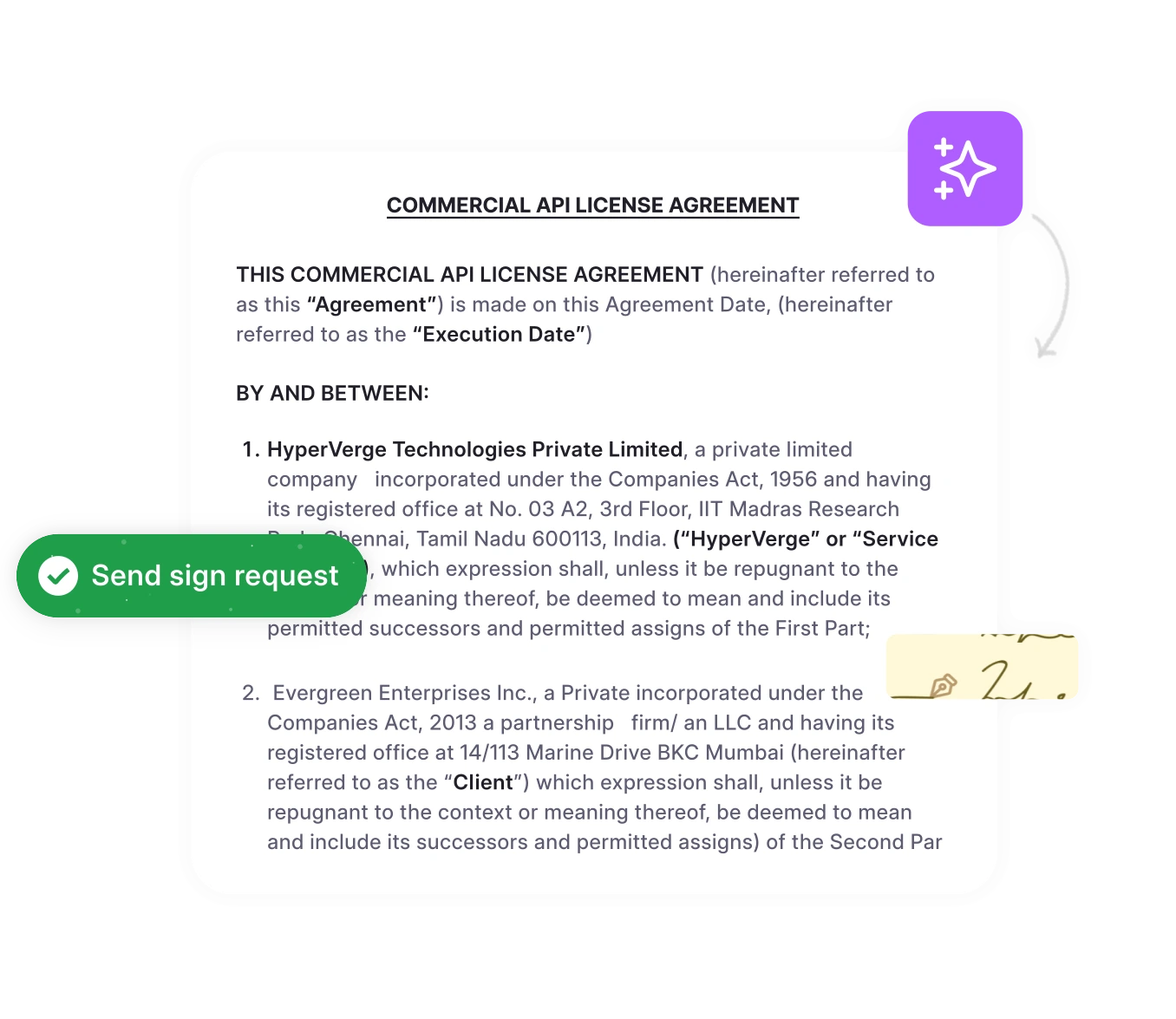The termination clause is your exit plan for ending a contract when a business relationship has served its purpose. Termination ranks as the 4th most negotiated term in contracts. It is a key part of any business contract — it explains how and when an agreement can end when a relationship is no longer relevant.
This guide will break down everything you need to know about this critical contract term, from its basic components to the strategic advantage of managing it with a modern CLM system.
What is a termination clause?
This contract clause is a section in a contract that outlines the specific conditions under which the agreement can be ended by one or all parties. It’s a roadmap for a professional disengagement.
The clause for contract termination answers critical questions: How can we end this? How much notice is needed? What’s the applicable law? What happens afterward? What does each party do if the agreement is ended early? Getting it right is important for legal compliance and managing operational risk.
Read also: Contract Termination Guide: Process & Best Practices
Why do you need a termination contract clause?
Without a clear termination clause, ending a contract can be messy, expensive, and lead to claims of “breach of contract.” This clause provides a clear, pre-agreed-upon method to end the relationship within the framework of applicable laws, protecting both parties from future disputes.
This clause provides a clear, pre-agreed method to end the relationship; such termination protects both sides. Establish dispute resolution mechanisms to seek reconciliation or identify ways to recover from a strained relationship before resorting to pulling the plug.
This is a key part of the Contract Lifecycle Management (CLM) process, specifically the “Close-Out” phase, which occurs when a decision is made not to renew a contract approaching its expiry or to actively terminate a contract for cause or convenience. Properly closing out a contract requires a range of activities to ensure a smooth transition and protect your business.
Read also, A Guide to Evergreen Contracts
Is Your Contract Exit Clear?
Hyperstart helps you manage complex termination clauses across your entire portfolio, so you’re never caught by surprise.
Book a DemoBig business vs. SMEs
This dynamic is especially critical when larger companies work with smaller partners. The data shows a clear tension:
- Big businesses are often less likely to offer flexibility on high-risk terms like termination rights.
- Many SMEs feel a sense of resignation, believing that standard terms, particularly around termination and limitation of liability, are non-negotiable.
Ideally, both sides must reach a mutual agreement about critical terms like exposure, insurance, confidentiality, and how to wrap things up or terminate early with mutual consent.
Common types of termination in business contracts
Your termination clause will typically specify one or both of these paths.
Termination for cause: When someone messes up
This is the “fault-based” exit. Termination for cause is triggered when one party breaches a core obligation, which is known as a material breach. If that happens, the non-breaching party usually has the right to end the deal after giving a few days’ written notice. If the problem isn’t fixed at that time, the contract ends on the termination date stated in such notice.
Employment contracts have extra layers — things like severance pay, employer duties, and employee rights are tightly regulated. A ‘for cause’ or cause clause in an employment context usually has to be handled carefully under labor law.
The New York Stock Exchange (NYSE) is the case of Richard Grasso v. NYSE. Grasso, the Exchange’s former CEO, argued he was involuntarily terminated without cause, triggering benefits under his employment contract’s termination clause. The clause required written notice, a defined notice period, and clear definitions of “Cause” and “Good Reason.” The dispute highlighted how failing to follow these procedures can invalidate termination benefits. Courts later emphasized that without proper written notice, termination provisions may not apply.
Read
Termination for convenience
This is the flexibility option. Termination for convenience allows a party to exit the contract for any reason, or no reason at all, without the other party being at fault. It offers a valuable escape hatch if strategies change, but it usually comes with specific requirements, like a longer notice period or sometimes even a termination fee, to balance the scales.
They would better serve service contracts or supplier contracts where outcomes are more flexible and business-driven. In which case, termination for convenience may be better enforced when the contract duration can close before natural expiration.
When Qatar Airways terminated supply agreements with Optimares S.p.A. under a “termination for convenience” clause, Optimares incurred $2.5 million. Sellers must read the fine print.
| Feature | Termination for Cause | Termination for Convenience |
| Reason for Termination | A material breach by the other party. | Any reason, or no reason at all. |
| Is a Breach Required? | Yes. | No. |
| Typical Notice Period | It can be short, especially for a severe breach. | Usually longer, to give the other party time to adjust. |
| Example | A supplier consistently misses delivery schedules. | A company restructures and no longer needs a service. |
What goes into a solid termination clause?
A well-drafted termination clause is more than just stating you can leave. It’s about defining the entire process. Here are the key ingredients:
How much notice do you have to give?
This specifies how far in advance a party must inform the other of its intent to terminate. Most contracts spell out how long the notice period should be and how that written notice should be sent.
The “cure” period
There’s often a short window — called a ‘cure period’ — where one side can fix the problem before such termination takes effect. It gives the breaching party a set number of days (e.g., 30 days written notice) to fix the problem after being notified. If they cure the breach within that time, the contract can often continue. If they fail to do so, the other party has the clear right to terminate.
What happens after termination
The end of the business relationship doesn’t mean all obligations cease. This section, sometimes called the “upon termination” clause, outlines what needs to happen next. Common post-termination obligations include:
- Returning confidential information and property.
- Processing a final payment.
- Assisting with the transition of services.
- Destroying or returning data.
Read also: Contract Clause Library: Benefits & Examples
Take Control of Your Contract Lifecycle
See how Hyperstart can simplify everything from creation to termination. Let’s build a smarter contract process together.
Book a DemoA quick note: General contracts vs. employment contracts
The rules can be a little different. While the principles are similar, termination clauses in employment contracts have additional layers of complexity. They are heavily governed by specific labor laws and regulations concerning severance pay, wrongful dismissal, and employee rights. What might be a standard termination for a convenience clause in a supplier contract could be completely unenforceable in an employment context.
Managing contract exits at scale
Tracking different termination rules manually is a waste of effort.
Imagine your company has thousands of active contracts with different termination dates, notice periods, and specific conditions. Relying on spreadsheets and calendar reminders is a recipe for missed deadlines, auto-renewing irrelevant deals, and opportunity costs.
This is where a smart system becomes non-negotiable. Contract Lifecycle Management (CLM) tools, like HyperStart, are built for this exact challenge. Procurement and legal teams use automations to send alerts months in advance when a contract is up for renewal or when a termination right becomes available. This gives you the lead time needed to negotiate from a position of strength.
In closing
A clean exit, ideally by mutual written consent, protects relationships and keeps both sides aligned. Even simple agreements benefit from quick input from legal professionals, and legal support functions need AI to make sure everything checks out on boilerplate contracts.
The good termination clause signifies prudent business planning. It ensures that both parties can part ways fairly and predictably, preserving professional relationships and protecting your organization from unnecessary risk. But in a portfolio of thousands of contracts, knowing your exit is only half the battle. The other half is having a system that reminds you when and how to use it.
Frequently asked questions
Alternatively, some contracts may end early because of a force majeure clause — things like a national emergency, energy supply issues, or another calamity.
Others might automatically terminate if a material adverse change affects the deal or if a business combination doesn’t go through.











